-
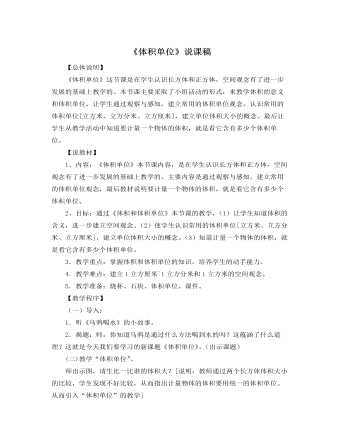
北师大版小学数学五年级下册《体积单位》说课稿
【教学程序】(一)导入:1.听《乌鸦喝水》的小故事。2.揭题:师:你知道乌鸦是通过什么方法喝到水的吗?这蕴涵了什么道理?这就是今天我们要学习的新课题《体积单位》。(出示课题)(二)教学“体积单位”。师出示图,请生比一比谁的体积大?[说明:教师通过两个长方体体积大小的比较,学生发现不好比较,从而指出计量物体的体积要用统一的体积单位。从而引入“体积单位”的教学]师:为了更准确的比较图中这两个长方体体积的大小,我们可以把它们切成若干个同样大小的正方体,只要数一数,每个长方体包含有几个这样的小正方体,就能准确地比出它们的大小。请生数一数,告诉老师谁的体积比较大?学生汇报(注意让学生说出数的方法)。师:像计量长度需要长度单位,计量面积需要面积单位,我们计量体积也需要有“体积单位”。为了更准确地计量出物体体积的大小,我们可以像图中这样用同样大小的正方体作为体积单位。
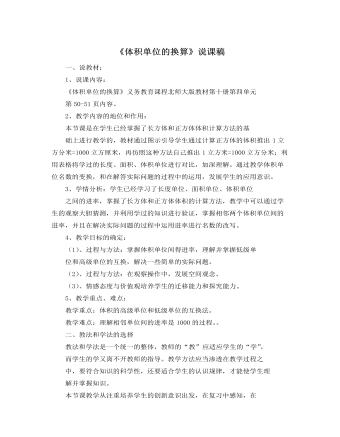
北师大版小学数学五年级下册《体积单位的换算》说课稿
1.要有充分的直观操作。学生思维的特点一般的是从感性认识开始,然后形成表象,通过一系列的思维活动,上升到理性认识。本课的教学采用直观操作法,是一个重要的环节。2.启发学生独立思考。学生是学习的主体,只有引导学生独立地发现问题、思考问题、解决问题,才能收到事半功倍的教学效果。3.讲练结合。4.充分运用知识的迁移规律,引导学生掌握新知识。教学过程:三、说教学过程:(一)、创设情境上课前,教师先给大家讲一个与今天的学习内容有关的故事,希望同学们认真地听、认真地想。故事是这样的:大象过生日啦!那天来了很多的朋友,有小兔、小猴等等等等,可热闹啦!在众多的朋友中只数小兔最高兴,它乐什么呢?原来它知道了蛋糕的分配方案,认为自己分的蛋糕比小猴的大。蛋糕是这样分配的:分给小兔的蛋糕是棱长10厘米的正方体,分给小猴的蛋糕是棱长1分米的方体。(分别出示两块同样大小的正方体,用10厘米和1分米表示它们的棱长)
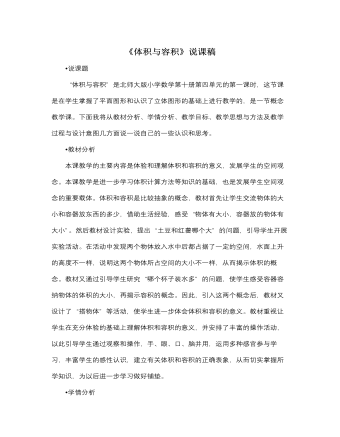
北师大版小学数学五年级下册《体积与容积》说课稿
学生掌握数学概念过程的本身就是一个把教材知识结构转化成自己认知结构的过程,这一过程的结果可能形成正确的数学概念,也可能由于主、客观原因而形成一些错误的数学概念。因此,在这一阶段有两大任务要完成,一是强化已经形成的正确认识,二是修正某些错误认识,使掌握的概念都能正确反映数学对象的本质属性。在情境中解决问题是从新课教学到学生独立作业之间的一个重要环节,目的在于巩固所学知识,并把知识转化为技能。教材“试一试”和“练一练”的第1、2题,让学生通过观察、思考,并且在有了比较充分的感性体验的基础上揭示体积概念及让学生充分感受同一物体形状变了,但体积保持不变,增强实际体验。“练一练”第3题,让学生体会到如果每个杯子的大小不同,那么3杯就可能等于2杯,这是为后面体积单位作铺垫。
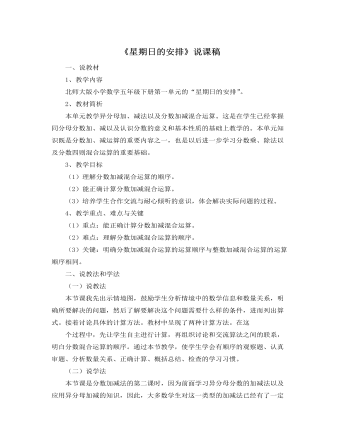
北师大版小学数学五年级下册《星期日的安排》说课稿
(一)说教法本节课我先出示情境图,鼓励学生分析情境中的数学信息和数量关系,明确所要解决的问题,然后了解要解决这个问题需要什么样的条件,进而列出算式。接着讨论具体的计算方法。教材中呈现了两种计算方法。在这个过程中,先让学生自主进行计算,再组织讨论和交流算法之间的联系,明白分数混合运算的顺序。通过本节教学,使学生学会有顺序的观察题、认真审题、分析数量关系、正确计算、概括总结、检查的学习习惯。(二)说学法本节课是分数加减法的第二课时,因为前面学习异分母分数的加减法以及应用异分母加减的知识,因此,大多数学生对这一类型的加减法已经有了一定的计算能力和计算方法,基于此,我在教学中将加减运算的学习和解决问题结合起来,在加强学生的计算能力的同时,更侧重了学生提出问题和解决问题的能力的训练,也就是让学生在经历探索运算方法的过程中,体验算法多样化。
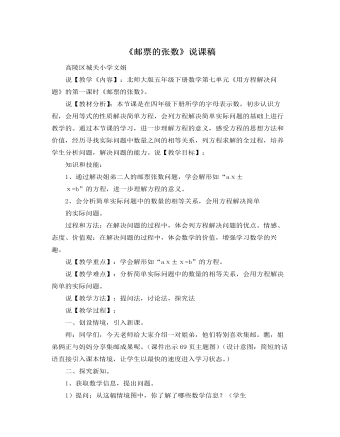
北师大版小学数学五年级下册《邮票的张数》说课稿
说【教学《内容】:北师大版五年级下册数学第七单元《用方程解决问题》的第一课时《邮票的张数》。说【教材分析】;本节课是在四年级下册所学的字母表示数,初步认识方程,会用等式的性质解决简单方程,会列方程解决简单实际问题的基础上进行教学的。通过本节课的学习,进一步理解方程的意义,感受方程的思想方法和价值,经历寻找实际问题中数量之间的相等关系,列方程求解的全过程,培养学生分析问题,解决问题的能力。说【教学目标】:知识和技能:1、通过解决姐弟二人的邮票张数问题,学会解形如“aⅹ±ⅹ=b”的方程,进一步理解方程的意义。2、会分析简单实际问题中的数量的相等关系,会用方程解决简单的实际问题。过程和方法:在解决问题的过程中,体会列方程解决问题的优点。情感、态度、价值观:在解决问题的过程中,体会数学的价值,增强学习数学的兴趣。
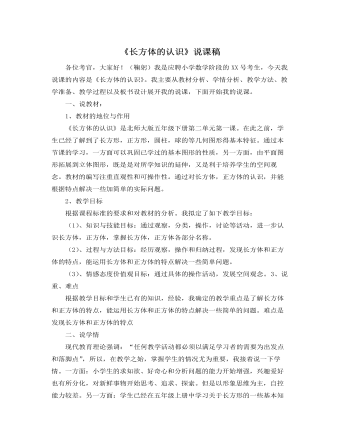
北师大版小学数学五年级下册《长方体的认识》说课稿
五、说教学过程为了高效地实现教学目标,整个教学过程分为如下几个环节进行:环节一:创设情景,导入新课在新课开始时,用多媒体课件以PPT的形式展示几幅含有长方体和正方体的图片。即建筑物,道路和家具。让学生通过观察图片找出其中的长方体。然后,让学生联系到生活中的物体,找出2到3个长方体的实物。并在这些实物的基础上呈现长方体的几何图形。也由此导入新课——长方体的认识,板书课题,长方体的认识。环节二:合作学习,探究新知。在这个环节中,我设计了这样几个活动,来落实教学目标。活动一,“数一数”。把学生分成几个小组,让他们观察手中的长方体纸盒,请他们找出长方体有几个面,再找出面与面之间的线,由此导入棱的概念,通过观察,他们发现每三条棱相交于一点。由此导入顶点的概念,再找出有几个顶点。并在设计的表格中板书。
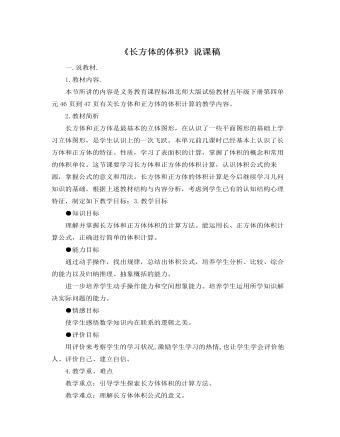
北师大版小学数学五年级下册《长方体的体积》说课稿
三、说学法有效的数学学习活动不是单纯地依赖模仿与记忆,而是一个有目的的、主动建构知识的过程。为此,我十分重视学生学习方法的指导,在本节课中,我指导学生学习的方法为:观察发现法、动手操作法、自主探究法、合作交流法,让他们在说一说、摆一摆、填一填、做一做、想一想等一系列活动中探索长方体体积的计算方法。我力求以"长方体、正方体体积"这一数学知识为载体,通过学生主动参与、自主探究、发现结论的过程,使学生的数学认知结构建立在自己的实践经验和主动建构之上。四、说教学流程教学时.我安排了情景引入.揭示课题,自主探究.推导公式,利用关系.类推公式,巩固练习.运用公式,全课总结.交流评价五个环节.(一)激情引趣.揭示课题.首先,通过比较生活中一些物体的大小,复习体积概念。

小学教学常规管理制度
一、教学常规与课程标准 、学期开始各年级各学科都要制定好学期教学计划,并努力做到教学目的明确,课时划分科学,教学进度清楚,时间分配合理,各人教研计划,于开学第一周上交办公室。 2、掌握本学科课程标准,做到学科教学目的清楚,教材结构清楚,学科特点清楚,重点难点清楚,学生的能力发展要求清楚。 二、备课 1、个人备课要做到备课程标准,备教材,备教学内容,备学生实际,备教学方法,备教学手段及教具,备教学练习,备能力培养措施,备德育美育的熏陶。 2、上课前必须写好教案,教案一般包括:课题、教学目标、重点难点、教学用具、教学过程、实验操作、作业布置、板书设计、课后小结。学期中应超前一周备课、教案字清楚整洁。 3、不得使用旧教案或以参考资料代替教案。
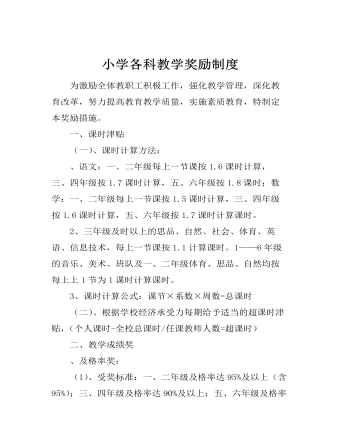
小学各科教学奖励制度
一、课时津贴 (一)、课时计算方法: 、语文:一、二年级每上一节课按1.6课时计算,三、四年级按1.7课时计算,五、六年级按1.8课时;数学:一、二年级每上一节课按1.5课时计算,三、四年级按1.6课时计算,五、六年级按1.7课时计算课时。 2、三年级及时以上的思品、自然、社会、体育、英语、信息技术,每上一节课按1.1计算课时。1——6年级的音乐、美术、班队及一、二年级体育、思品、自然均按每上上1节为1课时计算课时。 3、课时计算公式:课节×系数×周数=总课时 (二)、根据学校经济承受力每期给予适当的超课时津贴,(个人课时-全校总课时/任课教师人数=超课时) 二、教学成绩奖 、及格率奖: (1)、受奖标准:一、二年级及格率达95%及以上(含95%);三、四年级及格率达90%及以上;五、六年级及格率达85%及以上才能受奖。 (2)、奖励办法:凡达到标准要求者,根据所教班学生数,按每生1元计算,奖单科教师。 2、优生率奖: (1)、优生标准:一、二年级95分以上者;三、四年级90及以上者;五、六年级90分及以上者为优生。 (2)、奖励方法:按每科计算,优生每生奖1元。语文、数学双科优生,每生奖2元。 3、特优生奖:10元/生。 4、平均分奖:以区平均比较,每超一个百分点,按每生0.1元计奖。
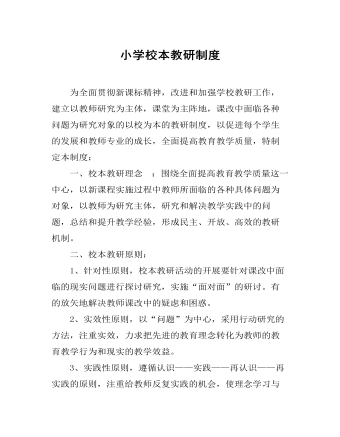
小学校本教研制度
一、校本教研理念 :围绕全面提高教育教学质量这一中心,以新课程实施过程中教师所面临的各种具体问题为对象,以教师为研究主体,研究和解决教学实践中的问题,总结和提升教学经验,形成民主、开放、高效的教研机制。 二、校本教研原则: 1、针对性原则,校本教研活动的开展要针对课改中面临的现实问题进行探讨研究,实施“面对面”的研讨。有的放矢地解决教师课改中的疑虑和困惑。 2、实效性原则,以“问题”为中心,采用行动研究的方法,注重实效,力求把先进的教育理念转化为教师的教育教学行为和现实的教学效益。 3、实践性原则,遵循认识——实践——再认识——再实践的原则,注重给教师反复实践的机会,使理念学习与教研活动紧密结合。
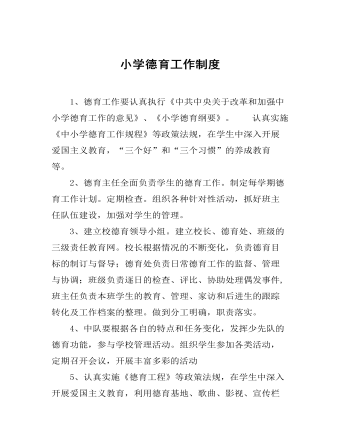
小学德育教育管理制度
2、建立校德育领导小组。建立校长、德育处、班级的三级责任教育网。校长根据情况的不断变化,负责德育目标的制订与督导;德育处负责日常德育工作的监督、管理与协调;班级负责逐日的检查、评比、协助处理偶发事件,班主任负责本班学生的教育、管理、家访和后进生的跟踪转化及工作档案的整理。做到分工明确,职责落实。 3、德育主任全面负责学生的德育工作。制定每学期德育工作计划。定期检查。组织各种针对性活动,抓好班主任队伍建设,加强对学生的管理。 4、认真实施《德育工程》等政策法规,在学生中深入开展爱国主义教育,利用德育基地、歌曲、影视、宣传栏等对学生进行教育。严格执行每周一升国旗制度。 5、中队要根据各自的特点和任务变化,发挥少先队的德育功能,参与学校管理活动。组织学生参加各类活动,定期召开会议,开展丰富多彩的活动

新人教版高中英语必修2Unit 2 Wildlife Protection-Reading for Writing教案二
This lesson aims at making a poster about protecting wildlife after reading some posters. During reading students are guided to understand the content and try to summarize the posters with one sentence. Then students are guided to try to make a poster about protecting wildlife.1. Read the two posters and try to understand the summary sentences.2. Look at the two posters and try to understand what emotions they express.3. Try to summarize the features of posters4. Try to make a poster about wildlife.1. Look at the two posters and try to understand what emotions they express.2. Try to summarize the features of posters3. Try to make a poster about wildlife.Step 1 Lead inLook at the the posters on the textbook and ask:Which emotions do the posters communicate ?Step 2 Read the poster and answer the questions.1. What do you think of the animals in the poster on the left ?I think it is frightening and ugly.2. Why do we should protect the ugly animals ?All species--the good, the bad, and the ugly-- should be treated equally.The world needs all kinds--without variety, our planet cannot survive.3. Why are billions of trees being cut down every year ?To make paper for humans.4. What result will be lead to after the trees are cut down ?A lost of animal homes are being destroyed./The habitat of wildlife is being destroyed.Step 3 Find the feature of posters1. What does each poster use to stir up emotions ?On the left, it makes us a little frightened and it looks a little ugly, but it can activate our curiosity--What is it? And What is wrong with it?On the right, it makes us feel a little sad and want to protect them.

新人教版高中英语必修2Unit 2 Wildlife Protection-Discovering Useful Structure教案二
2.表示现阶段正在进行的被动动作(该动作在说话的瞬间未必正在进行)。Many interesting experiments are being carried out these days.(说话时,并不一定正在进行)3.表示一种经常性的被动行为,常和always,constantly 等表示频度的副词连用,这种用法常常带有赞扬或厌恶的感情色彩。He is always being praised by the leader.4.表示按计划或安排主语将要承受谓语动词所表示的动作(仅限于少数及物动词)。A party is being held tonight.Step 4 Special cases1.像take care of, look after, talk about, think of等动词与介词构成的短语用于现在进行时的被动语态时, 其中的介词不可省略。The ways to stop illegally hunting are being talked about. 2.可与部分情态动词连用,表示对正在发生的事情的推测。She may be being punished by her mother.3.有时可表示按计划或安排将要进行的一个被动动作。A celebration is being held this weekend for his success.4.某些表示“状态、心理活动、存在”等的动词,如have,want,need,love,一般不用现在进行时的被动语态,而常用一般现在时的被动语态。With the population increasing,more land is needed.5.“be+under/in+n.”可表示现在进行时的被动意义。My computer is under repair.=My computer is being repaired.

新人教版高中英语必修2Unit 2 Wildlife Protection-Discovering Useful Structure教案一
The activity topic of this section is "report an ongoing event", and the structure is the passive voice of present continuous tense. Rare wild animals are suffering from large-scale poaching, and species are on the brink of danger. Rescue operations are underway. "Being" and "suffering" are the meanings of the present progressive passive voice.The usage of present progressive passive voice is of great importance in writing a good discourse and appreciating some difficult language items, so it is vital to master it and use it flexibly in a context.1. Motivate Ss to deepen the understanding of the usage of present progressive passive voice in a fixed context.2. Enable Ss to master the usage of present progressive passive voice and use it flexibly in a context.3. Lead Ss to construct sentences or appreciate sentences used master it and use it flexibly in a context.1. Help students to appreciate the function of the usage of present progressive passive voice in a sentence2. Instruct students to write essays using the proper usage of present progressive passive voice.Look at the picture and tell me what are workers doing? What is the house being done?

新人教版高中英语必修2Unit 2 Wildlife Protection-Reading and Thinking教案一
The listening and speaking part aims at how to protect and help endangered animals by listening, speaking and talking about the facts and reasons. This lesson analyzes the decreasing clause of Tibetan antelope population and the measures of protecting Tibetan antelopes. So students can be guided to learn to analyse the title and use different reading skills or strategies, like scanning, skimming and careful reading.1. Read quickly to get the main ideas and the purpose of going to Tibetan; read carefully to understand what the author see and think.2. Understand the sentences of the present continuous passive voice such as “Much is being done to protect wildlife.” and the inverted sentence “Only when we learn to exist in harmony with nature can we stop being a threat to wildlife and to our planet.”3. Enhance the awareness of protecting wildlife.4. Cultivate the reading methods according to different materials.1. Read quickly to get the main ideas and the purpose of going to Tibetan; read carefully to understand what the author see and think.2. Understand the sentences of the present continuous passive voice such as “Much is being done to protect wildlife.” and the inverted sentence “Only when we learn to exist in harmony with nature can we stop being a threat to wildlife and to our planet.”3. Cultivate the reading methods according to different materials.Step 1 Leading-inWatch a video about elephants and whales and then ask:Why are they endangered ? They are killed/hunted

新人教版高中英语必修2Unit 2 Wildlife Protection-Listening &Speaking&Talking教案
Listening and Speaking introduces the topic of “how to save endangered wildlife and help wildlife in their neighborhood.” Due to the continuous deterioration of the living environment, a large number of wild animals are always facing the threat of endangered or extinction. Listening and speaking period enables students to understand the fact and reason why wild species are disappearing from the earth at an amazing speed, and realize that human beings ought to enhance the awareness of protecting wild species as soon as possible.Listening and Talking introduces the theme of " how to help wildlife in Ss’ neighborhood.". Now there are many volunteers who spontaneously protect wild animals, carry out various activities according to local conditions, and contribute their own strength to local animal protection with practical actions. Middle school students are also enthusiastic participants. They organize activities in their spare time, and take this opportunity to make friends, broaden their horizons, cultivate team spirit and communication skills. This section describes a bird watching activity organized by several middle school students of Bird watching Club. It aims to stimulate students' interest, improve their understanding of bird watching activities, and use the language structure of “being used for; in order to, so as to, to, so that, in order that ” to express the purpose for communication and discussion.1. Guide students to understand the content of listening texts in terms of using visuals to predict content.2. Cultivate students' ability to guess the meaning of words in listening; discuss with their peers how to save endangered wildlife and help wildlife in their neighborhood.3. Instruct students to use functional sentences of the dialogue such as “I am concerned about…” “what do you know about the endangered animals in…" and so on to talk about one of the endangered animals.

新人教版高中英语必修2Unit 2 Wildlife Protection-Listening and Speaking教案
This lesson is about wildlife protection. The listening and speaking is about “How to protect endangered wildlife ?” Faced with the facts and numbers of wildlife loss, people begin to detect the reasons, then people such as the celebrities (Prince William and Yao Ming) are calling on to protect them. So students are guided to enhance the awareness of protecting wildlife and try to take part in some volunteer activities of protecting wildlife.1. Predict the content by using visuals. 2. Learn to use the sentences such as “I’m concerned about.... But now they are in danger. I want to know the reasons/why./ What can we do to protect them ?3. Learn from the stars like Prince William and Yao Ming and enhance the awareness of protecting wildlife.4. Guide students to try to put forward the solutions to the problems of wildlife protection and then discuss them with partners and present the results of discussion.5. Master the pronunciation of stressed syllables.1. Learn from the stars like Prince William and Yao Ming and enhance the awareness of protecting wildlife.2. Guide students to try to put forward the solutions to the problems of wildlife protection and then discuss them with partners and present the results of discussion.3. Learn to use the sentences such as “I’m concerned about.... But now they are in danger. I want to know the reasons/why./ What can we do to protect them ?4. Master the pronunciation of stressed syllables.Part A Listening and Speaking--- How to save endangered wildlifeStep 1 Lead in1. Point at the pictures on P14 and ask Q1: What message do these posters share?

新人教版高中英语必修2Unit 2 Wildlife Protection-Reading and Thinking教案二
The theme of this unit is human and nature, focusing on the theme of wildlife protection. Nature is a complex ecosystem, in which there are delicate balance between animals and plants. Because of the role of the food chain, the extinction of one species will produce influence, causing a series of chain reaction. Large scale extinction of species will have a serious and even irreversible impact on the ecosystem, resulting in immeasurable losses. Therefore, it is of great significance to protect wild species. To protect wild species is to protect human beings themselves. The motto of this unit is "when the buying stops, the killing can too,” which is a public service advertising slogan to protect wildlife. It tells people that every rhinoceros horn, every fur, every bowl of shark fin soup, every Ivory product, and every tiger bone product, etc. consumed by human beings, are innocent wild animals slaughtered behind them. The mission of wild aid is to ban illegal trade in endangered wildlife and mitigate climate change. It aims to educate the public to reduce the consumption demand for endangered wildlife products through public publicity and improve the awareness of environmental protection.1. Improve the awareness of wildlife protection by acquiring the knowledge of wildlife protection.2. Focus on environmental protection and protection of all lives.3. Analysis of the living environment of wild animals with appropriate thinking mode.4. Skillfully use the vocabulary and grammar knowledge of this unit to cultivate self-study ability according to the unit content5. Develop cooperative learning ability through discussion and other ways1. Enable the Ss to talk about the current situation of wild animals.2. Guide the Ss to summarize the main idea of each paragraph as well as the main idea of the text.

新人教版高中英语必修2Unit 2 Wildlife Protection-Reading For Writing教案一
1. 标题首先根据海报的特点、格式写明标题。海报中往往把内容作为大标题。例如: Save the earth, Save the birds。2. 正文部分不同的海报其正文部分的侧重点不同。对于介绍性的海报, 首先要引出话题, 其次列出原因, 最后是总结。对于宣传类的海报, 要写明具体内容, 如: 活动内容, 地点以及参加活动的注意事项, 主持或举办单位等。1. 图片: 要选择引人注目的图片, 与主题要相关, 色彩明亮。话题句式 1. It is a treasure of our country. 它是我国的国宝。2. Believe it or not, at present only several thousand pandas exist in the world. 信不信由你, 目前世界上仅现存几千只熊猫。 3.It’s because of human activities that tigers are endangered. 正是因为人类的活动, 老虎处于濒危的状态。4. Many wild animals are in danger of dying out. 很多野生动物面临着灭绝的危险。 5. The government has taken effective measures to protect them. 政府已采取有效的措施来保护它们。6. People should raise the awareness of the protection of wild animals. 人们应该提高保护野生动物的意识。 7. It’s amazing that there are merely less than 1, 000 finless porpoises living in China. 非常令人吃惊, 目前中国仅有不足1 000只江豚。

新人教版高中英语必修1Unit 2 Travelling Around-Discovering Useful Structure教案
(5)be to do (可以和具体的时间状语连用)①表示按计划、安排即将发生的动作。②用于时间、条件状语从句中,表示“如果要……,想要……”。The students are to meet at the school gate tomorrow. 明天学生们将在学校大门口集会。 If you are to succeed, you must work as hard as possible. 如果你想要成功,比必须努力工作。(6)be about to do (不与具体的时间状语连用) 表示即将要发生的动作。We are about to start. 我们就要出发了。The new school year is about to begin. 新学年开学在即。(7)一般现在时表将来①表示按时间表规定将要发生的动作。常限于表示位置移动的短暂性动词。②在时间、条件或让步状语从句中,用一般现在时表将来。Look at the timetable. Hurry up! Flight 4026 takes off at 18:20. 你看看时刻表,快点!4026次航班的起飞时间是下午6点20分。Jane is in a hurry because the train to the airport leaves in half an hour. 简很匆忙,因为去机场的火车半小时后出发。

